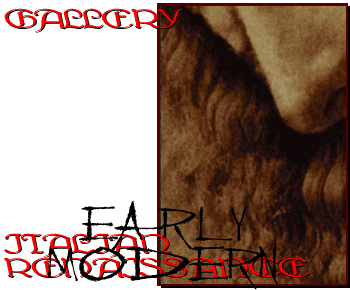


|
Michelangelo Buonarotti, The Last Judgement: Center Section Michelangelo was commissioned by Pope Paul III to paint the wall of the Sistine Chapel in 1536. Twenty years earlier he had been commissioned by Julius II to paint the ceiling of the chapel, which Michelangelo considered the least important part of the chapel. This work, however, was so well-received that Paul III was anxious for him to do the central wall. This final frescoe, The Last Judgement, painted between 1536 and 1541, represents Christ in his glory judging the souls of the dead. Located in the center of the wall, Christ is a figure of both stability and motion as the souls rise to the ceiling or fall to the floor and damnation. This painting was executed at the height of the Reformation and Paul III's Counter-Reformation. All the issues circulating about the reform of the church as well as the confusion engendered by the Reformation are represented in this painting. There is, despite the confusion of human souls, a stable center to the spiritual universe represented in the painting. Copyright, 1995, Corel Corporation. See the Corel License Agreement under which these pictures are published. This image is to be used only for educational activities in connection with the classes connected to this site. To include a browser-sized version of this picture in your multimedia projects, make a link to http://www.wsu.edu:8080/~dee/GRAPHICS/GALLERY/MICHEL/MICHEL1S.JPG |

|
Michelangelo Buonarotti, The Last Judgement: Center Section Detail Copyright, 1995, Corel Corporation. See the Corel License Agreement under which these pictures are published. This image is to be used only for educational activities in connection with the classes connected to this site. To include a browser-sized version of this picture in your multimedia projects, make a link to http://www.wsu.edu:8080/~dee/GRAPHICS/GALLERY/MICHEL/MICHEL2S.JPG |

|
Michelangelo Buonarotti, Madonna with Child This is a contested drawing that some consider by Michelangelo and others consider as by another artist. The drawing style is very close to Michelangelo's, including the cross-hatching on the figure. Copyright, 1995, Corel Corporation. See the Corel License Agreement under which these pictures are published. This image is to be used only for educational activities in connection with the classes connected to this site. To include a browser-sized version of this picture in your multimedia projects, make a link to http://www.wsu.edu:8080/~dee/GRAPHICS/GALLERY/MICHEL/MICHEL3S.JPG |

|
Michelangelo Buonarotti, Cleopatra This is one of the few authenticated drawings of Michelangelo and was drawn for Tommaso de' Cavalieri, a young artist that Michelangelo passionately loved. This is the only drawing, of what Michelangelo claimed many drawings presenting to Cavlieri, that we have left. The drawing is a study for a bust of Cleopatra and possibly represents the conflicted nature of Michelangelo's love for Cavalieri since Cleopatra was widely understood in the Renaissance as immasculating Caesar and later Marc Antony with her beauty. Copyright, 1995, Corel Corporation. See the Corel License Agreement under which these pictures are published. This image is to be used only for educational activities in connection with the classes connected to this site. To include a browser-sized version of this picture in your multimedia projects, make a link to http://www.wsu.edu:8080/~dee/GRAPHICS/GALLERY/MICHEL/MICHEL4S.JPG |

|
Michelangelo Buonarotti, Study of a Nude Man This is a contested drawing that some consider by Michelangelo and others consider as by another artist. As a nude figure, the erotics are fairly low key and the picture seems largely a study in motion and geometry. Copyright, 1995, Corel Corporation. See the Corel License Agreement under which these pictures are published. This image is to be used only for educational activities in connection with the classes connected to this site. To include a browser-sized version of this picture in your multimedia projects, make a link to http://www.wsu.edu:8080/~dee/GRAPHICS/GALLERY/MICHEL/MICHEL5S.JPG |

|
Michelangelo Buonarotti, Study of a Nude Man This is a contested drawing that some consider by Michelangelo and others consider as by another artist. Like much of Michelangelo's work, this drawing of a male nude in part is about finding a language for male-male love and desire. The erotics of the drawing is balanced by the reaching out of the arm and hand, a symbol of the desire for God in Neoplatonism Copyright, 1995, Corel Corporation. See the Corel License Agreement under which these pictures are published. This image is to be used only for educational activities in connection with the classes connected to this site. To include a browser-sized version of this picture in your multimedia projects, make a link to http://www.wsu.edu:8080/~dee/GRAPHICS/GALLERY/MICHEL/MICHEL6S.JPG |
